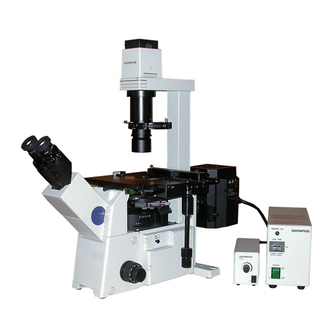Olympus IX71 Brochure & specificaties - Pagina 5
Blader online of download pdf Brochure & specificaties voor {categorie_naam} Olympus IX71. Olympus IX71 16 pagina's. Microscope z-axis motor drive
Ook voor Olympus IX71: Installatiehandleiding (11 pagina's)

Improved S/N ratio enables efficient detection of
even weak fluorescence.
FL
FL
Fluorescence Observation Units
Better S/N ratio delivers brighter, higher-contrast
images in fluorescence observation.
The ideal microscope allows bright, high contrast fluorescence
observation from the minimum amount of excitation light in order to
minimize cell damage or fluorescence fading. To detect a weak
fluorescence signal (S) efficiently, all other light noise (N) must be
reduced. Therefore, it is very important for fluorescence observation
to maximize the signal (S) and to minimize the noise (N).
S
Measures to enhance the signal (S)
q
Fluorescence objectives with high N.A.
w
Filters matched to the wavelength
characteristics of individual
fluorochromes
q
w
N
Measures to reduce noise (N)
q
Objectives without autofluorescence
w
No crossover between excitation &
emission light with new introduced
filters.
r
w
e
Optical system that prevents entry of
stray light
e
r
Ring slit illumination to reduce
autofluorescence
High performance mirror units
U-MNIBA3
100
90
DM505
80
70
BP470-495
60
50
40
BA510-550
30
20
10
0
450
500
550
600
Wavelength (nm)
The sharp performance of the dichromatic mirror in the new mirror unit minimizes crossover with the excitation filter and reduces
excitation light leakage to less than a tenth of our conventional models. Combined with the light absorbing mechanism (which absorbs
more than 99% of stray light), a high S/N ratio is achieved without the need for any special mechanism to prevent excitation light leakage.
7
High S/N ratio objective with reduced autofluorescence
q
Olympus offers a range of other high numerical aperture
objectives whose reduced autofluorescence and specially selected
glass contribute to improved fluorescence S/N ratios.
Especially the PLAPON60XO has outstanding N.A., which is 1.42.
N.A.
W.D . (mm)
UPLSAPO 10X2
0.40
3.1 mm
UPLSAPO 20X
0.75
0.6 mm
UPLSAPO 40X2
0.95
0.18 mm
UPLSAPO 60XO
1.35
0.15 mm
UPLSAPO 100XO
1.40
0.13 mm
PLAPON60 XO
1.42
0.15 mm
UPLFLN40XO
1.30
0.2 mm
LUCPLFLN 20X
0.45
6.6 — 7.8 mm
LUCPLFLN 40X
0.60
2.7 — 4 mm
LUCPLFLN 60X
0.70
1.5 — 2.2 mm
High-performance fluorescence mirror units for fluorescent proteins
w
Olympus has developed outstanding filter coating technology,
which gives the high efficient transmission and the reflection as well
as sharp cut off characteristics. This newly developed coating
results in optimized mirror units for the various fluorochromes
included ECFP/EGFP/EYFP/DsRed.
Improved performance of interference type fluorescence mirror unit
w
The S/N ratio of certain interference type fluorescence mirror
units is now improved, thanks to the application of new coating
technology to narrow the gap between excitation (Ex) and emission
(Em). The line-up has been extended for wide variety of choice.
U-MGFPHQ
100
BP460-480
90
DM485
80
BA495-540
70
Ex
60
50
40
30
Em
20
10
0
650
400
450
500
550
600
650
Wavelength (nm)
Ring slit illumination unit to reduce noise / IX2-RFRS
r
The ring slit illumination IX2-RFRS makes the ring shape
illumination on the objective to allow excitation light to pass through
S
N
the objectives outer portion
to not to excite the objective
auto-fluorescence generated
at the center of an objective.
Normal illumination
Illumination
SIGNAL
NOISE
S/N
Specimen
Objective
Excitation
Excitation
filter
light
S
N
Ring slit
Hg lamp
Xe lamp
General observation
Annular illumination
Glass reflector captures fluorescence of multiple color dyes
S
N
A multi-band dichromatic mirror is normally used to obtain multi-
color images of multiple stained fluorescent samples by using filter
wheels on the excitation and emission sides. However, this kind of
mirror encounters the problem that each fluorescence image gets
darker as the number of color dyes increase, because the
transmission spectrum becomes narrower and the transmittance
falls to lower than 90% at best. Olympus has therefore developed
the world's first glass reflector that is not wavelength-dependent,
offering a high transmittance of 94% across a wide wavelength
range from 430 nm to 700 nm. Used in combination with the filter
wheels on the excitation and emission sides, a wider variety of color
dyes can be used and
fluorescence images are captured
more efficiently.
*Special order basis product
Glass reflector specifications
26 X 38 mm (t=1 mm) glass substrate
Transmittance 94% (at 430-700 nm)
26 X 38 mm
* Observations through eyepieces may have
some restrictions
100
80
60
40
20
0
400
500
600
Wavelength (nm)
N
Stray light reduction function equipped on all mirror units
e
The slight transmission of stray light when excitation light is
reflected in the dichromatic mirror causes a rise in the level of noise.
Olympus mirror units absorb more than 99% of this stray light
through their light absorber.
Ring slit illumination
Normal
Annular
408
479
Light
Excitation light:
36
18
source
Illumination light
11.3
26.6
Excitation filter
Dichromatic
mirror
IX2-RFRS and IX2-RS40/60/100
Auto-
fluorescence
S
Usage examples of the glass reflector
Sapphire-pm.
YFP-mt
Glass reflector transmission properties
Sapphire
Simultaneous imaging of Sapphire, CFP, YFP, and RFP. HeLa cells were imaged for
CFP
Sapphire-pm, CFP-CaM, YFP-mt, and DsRed-nu. The images were obtained using the glass
YFP
DsRed
reflector in a normal cube.
*Solid line: excitation, Dotted line: emission
Optical components used for a 4-fluorophore imaging
Excitation filter
Dye
ND Filter*
Emission filter
Sapphire-pm
CFP-CaM
—
YFP-mt
DsRed-nu
700
*
1
ND filters in the holder of the illuminator.
New FL system
N
Specimen
Objectives
Stray light
Stray light
reducing
function
Emission filter
Fluorescence light
for observation
CFP-CaM
DsRed-nu
1
Excitation Light Path
Reflector
Emission Light Path
400DF15
535DF2
440DF20
Glass
480DF30
490DF20
535DF25
546DF10
595RDF60
8
